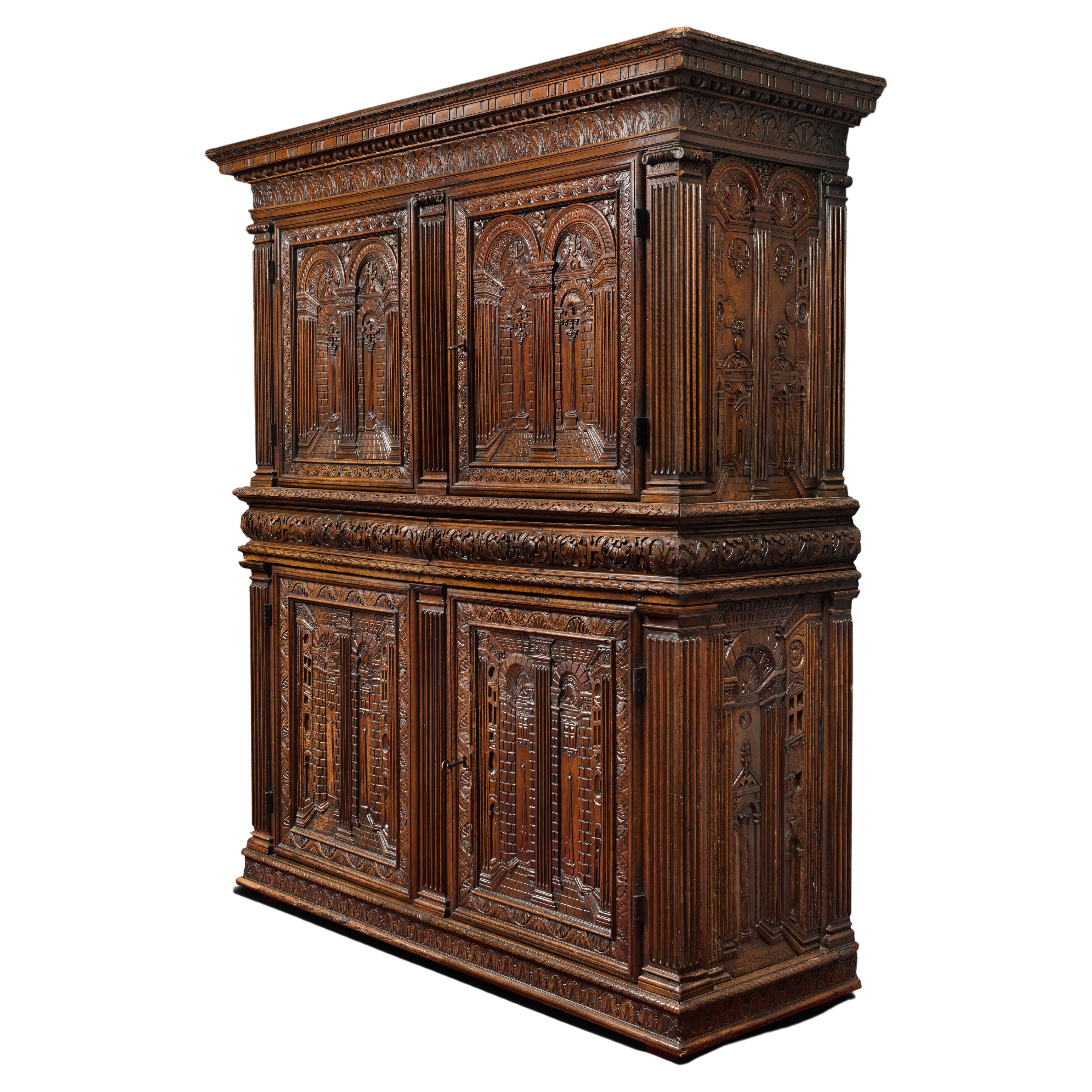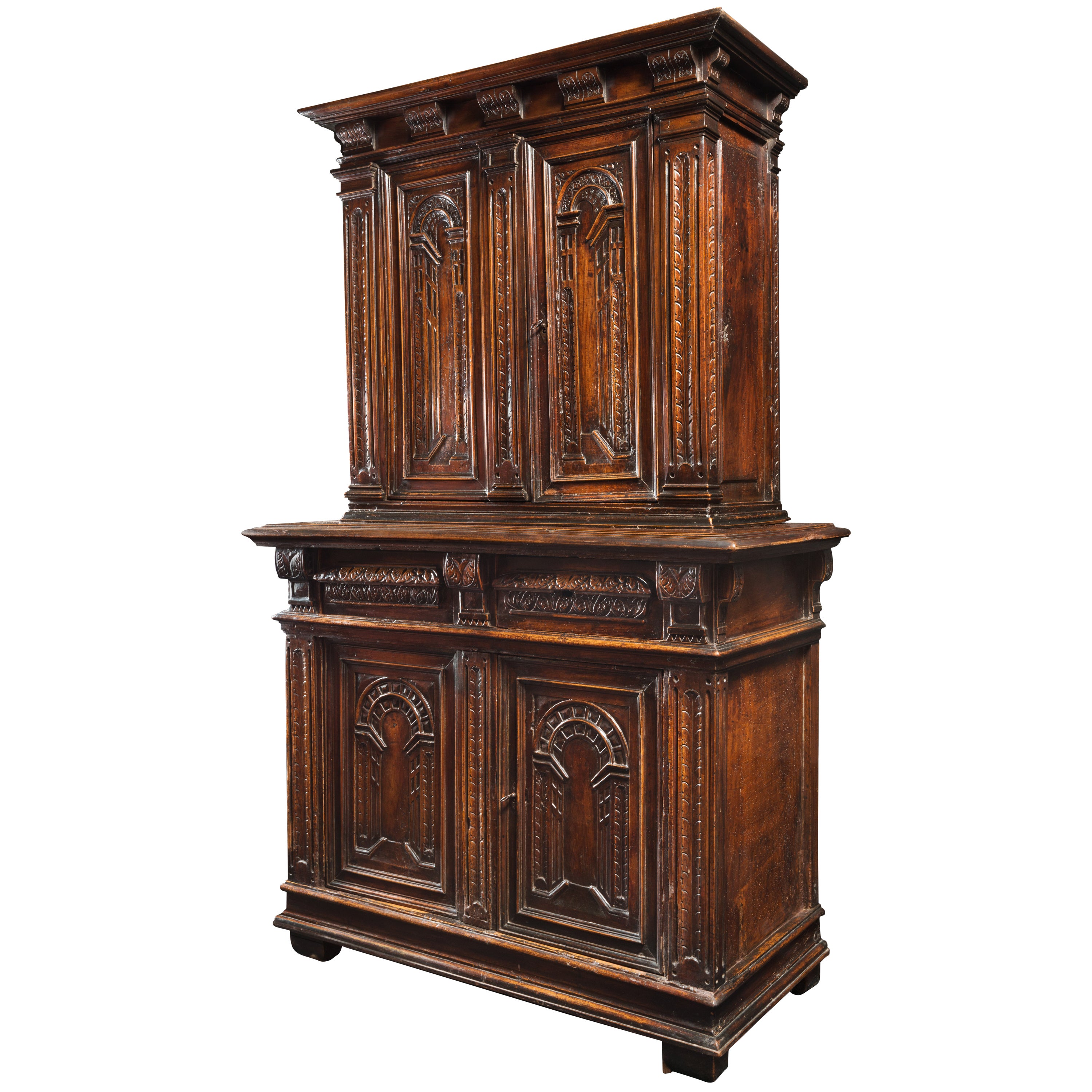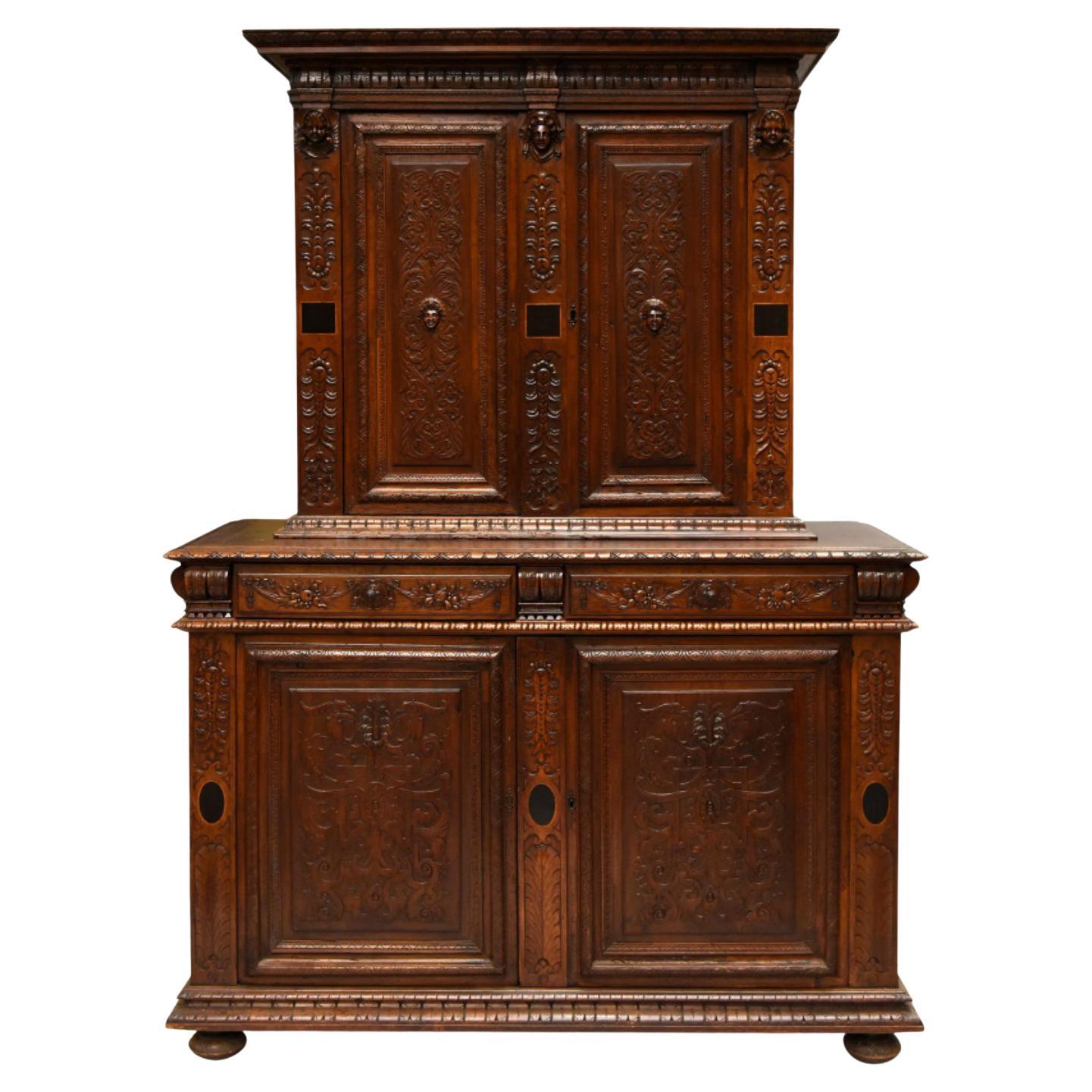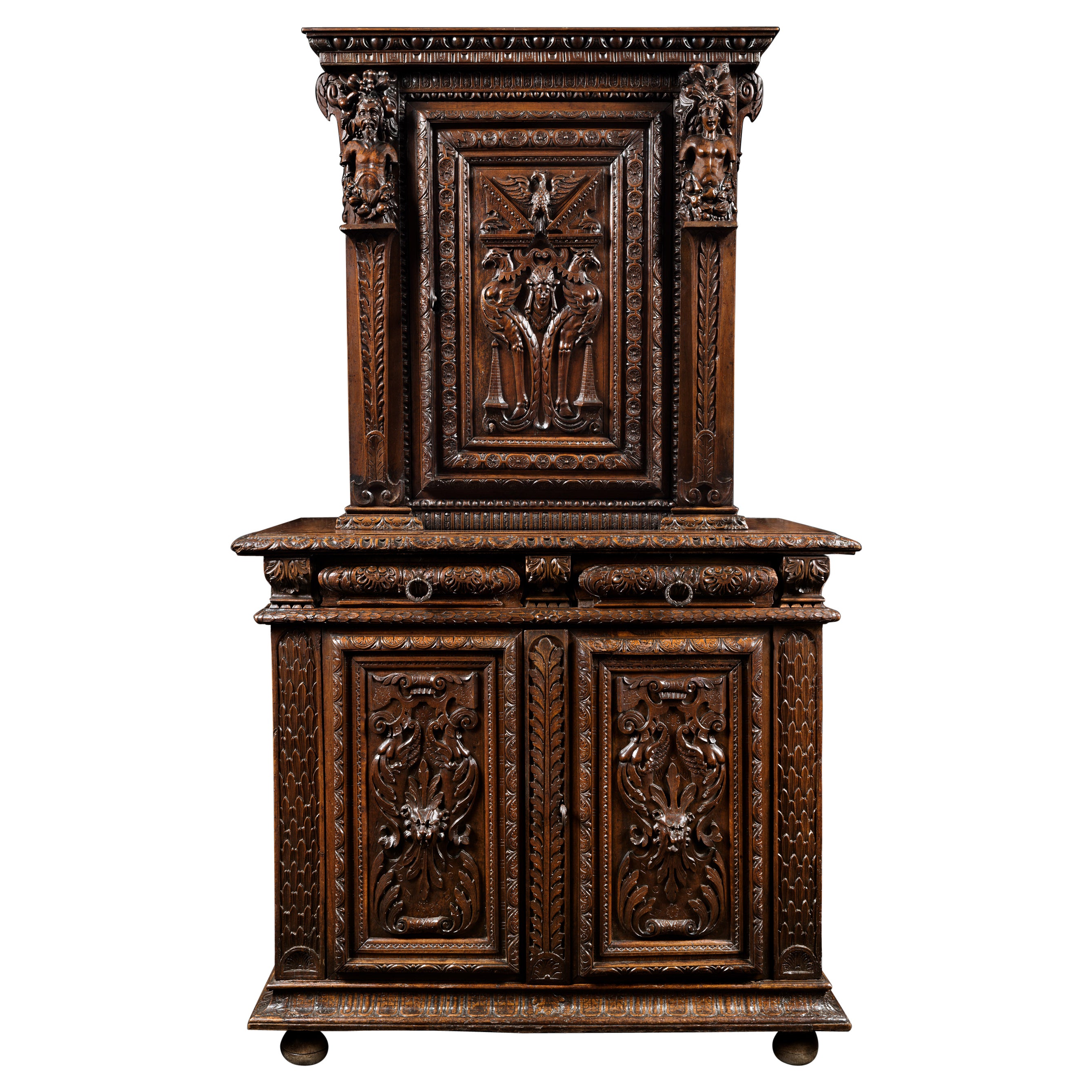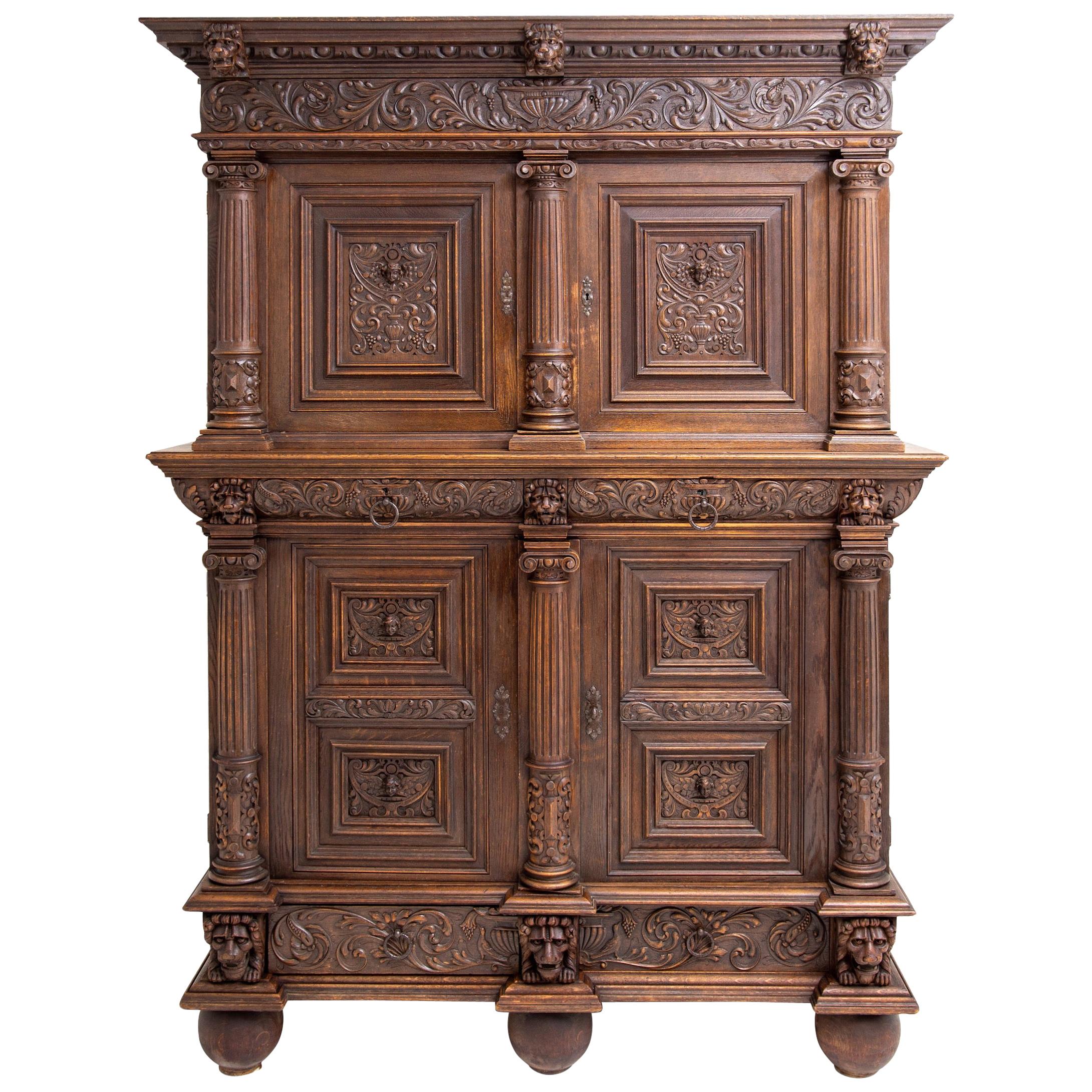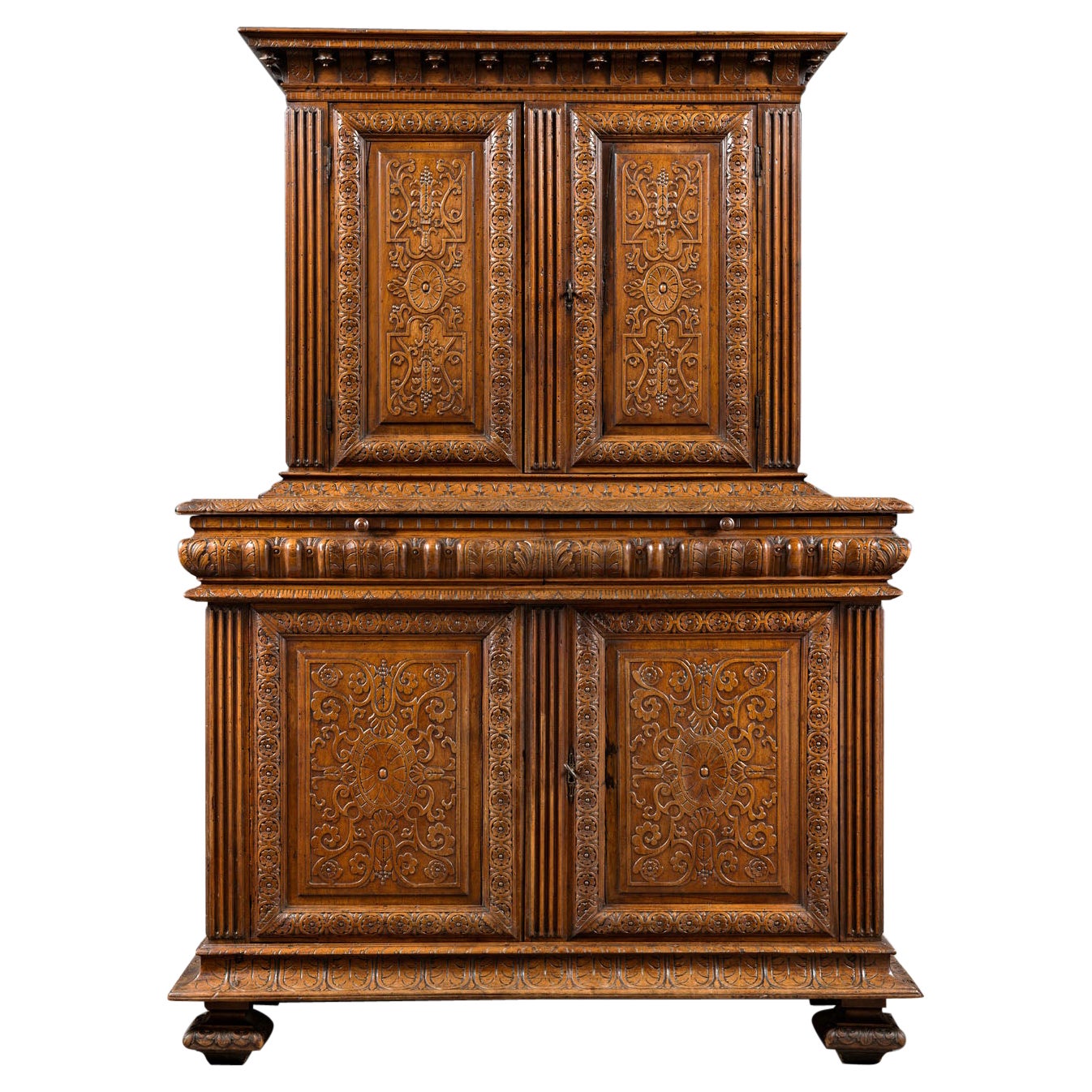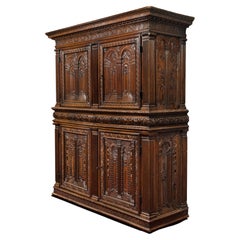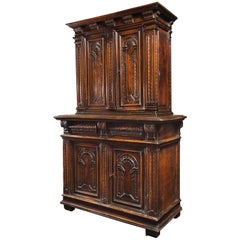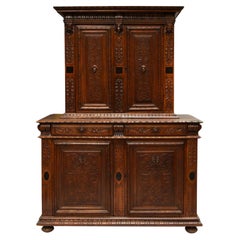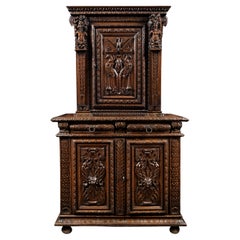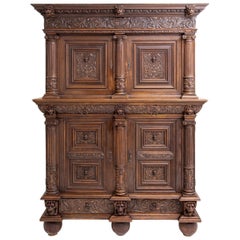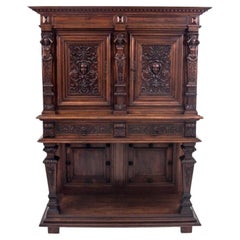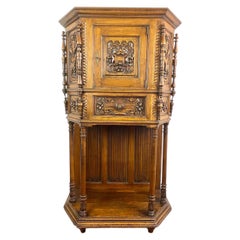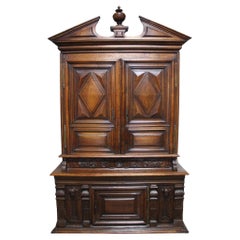Items Similar to Renaissance Cupboard from Loire Valley, 'France'
Want more images or videos?
Request additional images or videos from the seller
1 of 7
Renaissance Cupboard from Loire Valley, 'France'
$131,795.79
£98,113.40
€110,000
CA$180,527.29
A$200,785.75
CHF 104,844.08
MX$2,443,349.05
NOK 1,339,018.91
SEK 1,255,763.51
DKK 837,391.60
Shipping
Retrieving quote...The 1stDibs Promise:
Authenticity Guarantee,
Money-Back Guarantee,
24-Hour Cancellation
About the Item
This cabinet is composed of two bodies, the upper one being recessed. The extraordinary proportions are enriched by a mythological and floral carved decor.
The Lower body stands on a moulded base with four bun-feet. It opens thanks to two door-leaves framed by male terms. Their sheaths bear angel heads, fruits and flowers. They have pointed ears and thick moustache and carry a fruits basket on their heads. The central term is a female one.
On each door-leaf a moulded frame is centered by a niche in which is carved almost in the round a human figure. The niche’s broken pediment is supported by harpies carvings.
The two characters rising proudly inside the niches come from mythologic tales.
Represented in their heroic nudity a drape is folded on their forehead and falls back showing the most beautiful effect. The personnage on the left can be recognized with no doubts as Zeus (Jupiter) holding in his left hand the thunderbolt. The right hand side personnage has lost the attributes that would have allowed an easy identification. Nevertheless he could be Pluto (Hades), ruler of the underworld and was probably carrying a fork. Furthermore the shadow at his feet let us think he was accompanied by Cerberus, the three-headed dog guarding the gates of the underworld. An engraving by Giovanni Jacopo Caraglio after Rosso Fiorentino depicts Pluto in a way that is very close to our sculpture.
The lateral sides of the cupboard are ornated by a rose linked with a ribbon to two semi-roses.
Above this part the belt bears three human-like masks. It opens with two drawers enriched by vegetal scrolls emerging from putti heads.
The upper body is divided into several registers and shows a strong recess. The lower part is composed of two carved panels depicting pointed-hears grinning masks wearing earrings and from which emerge vegetal scrolls. Behind those panels hide two drawers closed thanks to a secret mechanism. Indeed those drawers can be locked from the inside of the cupboard by placing a dowel at the right place. The lack of handle or lock prevent anyone from guessing drawers are hidden.
The main part of the upper body is divided by three corinthian columns with a plain shaft and finely carved scrolls on its base. The door-leaves present a similar composition compared to the lower door leaves.
Two other gods are depicted in the niches. On the left hand side Venus (Aphrodite) with Cupid (Eros) and on the right hand side Mercury (Hermes).
Venus is naked and carries in her right hand a flaming torch symbolizing love. We can recognize her son with his wings and his quiver.
Mercury, son and messenger of Jupiter is identified by his winged sandals and his petasus. In his left hand he holds a trumpet while in the other hand he carried the caduceus.
The upper body is topped by an entablature and an extraordinary pediment. The entablature is composed of an architrave divided in two panels. Each one shows a carved decor centered by a shield on a cut-out leather held by two child-like creatures with vegetal bodies.
The large broken circular pediment carries on the acroterions a female and a male figure. Inside the central part of the pediment two corinthian columns framed by chimeraes support an entablature. In this little niche is depicted Minerva (Athena). The goddess of wisdom wears the peplos and holds on the ground her shield with the gorgoneion, Medusa’s face.
On the top of the triomphal element is standing Mars, god of war with a helmet on his head and wearing his armour.
Historical context
The second French Renaissance, starting around 1545, provoked a profound renewal in the furniture making.
The furniture structure with its harmonious proportions finds inspiration in the architecture. Antic orders are in vogue, thanks to architectural treaties such as Vitruve’s.
The ornamental vocabulary has also changed. Italian art’s influence shaped by humanism and antic discoveries leads to an evolution in decorative motifs. The presence of Italian artists -Il Rosso, Il Primaticcio, Niccolo dell’Abbate- on royal building sites allow a revitalisation of French art. Thanks to engraving and its diffusion, artists from all over the realm can discover and use this new vocabulary. Palm leaves, acanthus, flower garlands, grape fruits appear. This luxurious flora is accompanied by a fabulous fauna with harpies and chimeraes. The caryatid order knows a strong favor and artists love to use those figures on rich sheaths. Antic mythology is also very much in use being a pretext to sensual depictions, naked and muscular bodies.
Wood-carvers from the second half of the 16th century often find inspirations in those books of ornaments. The cupboard we present to you exhibits every characteristics of this second French Renaissance. One can only admire the beautiful unity of its decor, a legacy of Fontainebleau art. The gods and goddesses in the niches are depicted in a refined and supple manner. It can be compared to Giovanni Jacopo Caraglio 1526 engravings after Rosso Fiorentino’s set of Divinités de la Fable. Represented inside niches these elegant divinities were perfectly adapted to a cupboard’s door leaves.
Furthermore this cabinet is exceptional by the quality of its wood and because of the mastery of its maker. The law-reliefs and in the round carving’s delicacy of execution, the details worthy of a goldsmith testifie of this wood-carver gifts.
This two bodies cupboard stands as a particularly precious exemple of the second French Renaissance during the late 16th century.
Bibliography
Jacqueline BOCCADOR, Le mobilier français du Moyen-âge à la Renaissance, Ed. Monelle Hayot
Jacques THIRION, Le mobilier du Moyen-âge et de la Renaissance et France
James HALL, Dictionnaire des Mythes et des Symboles.
- Dimensions:Height: 93.31 in (237 cm)Width: 44.1 in (112 cm)Depth: 18.51 in (47 cm)
- Style:Renaissance (Of the Period)
- Materials and Techniques:
- Place of Origin:
- Period:
- Date of Manufacture:circa 1580
- Condition:Repaired. Wear consistent with age and use. Minor losses.
- Seller Location:Saint-Ouen, FR
- Reference Number:1stDibs: LU3115327266262
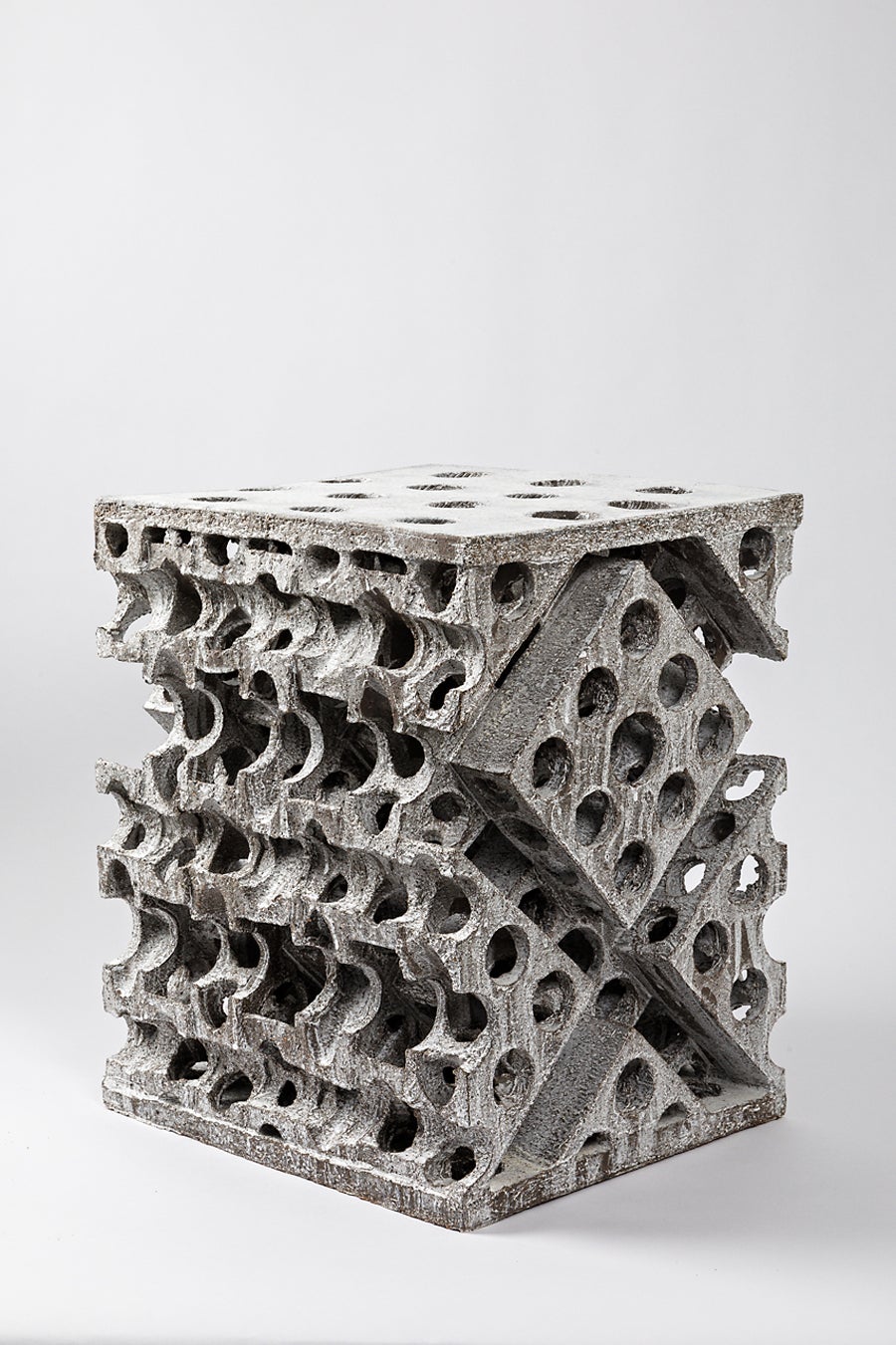
About the Seller
5.0
Vetted Professional Seller
Every seller passes strict standards for authenticity and reliability
Established in 2016
1stDibs seller since 2017
189 sales on 1stDibs
Typical response time: 2 hours
- ShippingRetrieving quote...Shipping from: Saint-Ouen, France
- Return Policy
Authenticity Guarantee
In the unlikely event there’s an issue with an item’s authenticity, contact us within 1 year for a full refund. DetailsMoney-Back Guarantee
If your item is not as described, is damaged in transit, or does not arrive, contact us within 7 days for a full refund. Details24-Hour Cancellation
You have a 24-hour grace period in which to reconsider your purchase, with no questions asked.Vetted Professional Sellers
Our world-class sellers must adhere to strict standards for service and quality, maintaining the integrity of our listings.Price-Match Guarantee
If you find that a seller listed the same item for a lower price elsewhere, we’ll match it.Trusted Global Delivery
Our best-in-class carrier network provides specialized shipping options worldwide, including custom delivery.More From This Seller
View AllImportant Renaissance Cabinet from Lyon 'France' with a Decor of Perspectives
Located in Saint-Ouen, FR
As soon as 1540 France's second Renaissance is in the making, intimately linked to the rediscovery of the Antique world. The development of the printing and engraving industry allows the spread of artworks and models in many cities and countries. The Italian influence can be perceived in every artistic field. While the French king entrust the most talented Italian artists with major projects such as Il Rosso or Primaticcio in Fontainebleau, French artists also travel to Italy to form themselves to this new style. In Italy they get acquainted with the work of Leo Battista Alberti the first to theorize perspective (De Pictura, 1435-36) and architecture (De re oedificatoria, 1541). Those two publications would have a revolutionary impact on arts.
Furniture is marked by the work of the most famous Italian architects of the time as well as French architects. Indeed Philibert de l'Orme competes with Alberti and by the end of his life publishes several treaties including one devoted to a theory of architecture (1567). Unfortunately he would not live to complete the second volume. In this treaty he expresses his interest for mathematical norms applied to architecture, copied from the Antique. His journeys in Italy allowed him to accumulate the most sophisticated references. Jean Bullant, another architect of great talent also theorizes his practice. He establishes rules characterizing Greco-Roman art staying faithful to Vitruvius.
Following this new inspiration the structure of furniture evolves. From then on appear columns, capitals, cornices, friezes and architraves. The ornamentation uses this inspiration as well with egg-and-dart, palm leaf and rose adorning the most beautiful pieces.
In Lyon, crossroad where meet merchants from everywhere those new experiments are welcomed. Lyon florishing printing industry allows the spreading of models and treaties essential to the artist's work. Thus the first publication of Vitruvius' De Architectura in France would be printed in Lyon in 1532.
Artists from Lyon rediscover and familiarize themselves with the Antique knowledge very early. They adopt those new ideas and use them in their own creations. Lyon cabinet-makers re interpret Antique architecture and Italian Renaissance palaces to give their pieces a pure and harmonious architectural structure. Grooved pilasters are particularly favored. They are topped by capitals of diverse orders always respecting the sequencing with simpler ones for the lower levels and the richest ones on the higher levels. As for the ornamentation, one of the great distinctiveness of Lyon workshops remains the architectural perspective illusions, drawing inspiration from Tuscany.
True masterpiece of the Second French Renaissance this important cabinet illustrates Lyon workshops' taste for fine Italian architecture inspired by Antiquity. An architectural perspective of great quality is treated in symmetry on each panel.
This two-bodied cabinet without recess stands on four rectangular feet. The base comprises a molding, a palm leaf frieze and is bordered by a braid.
The lower body is divided by three grooved pilasters with Tuscan capitals framing two door-leaves. The two panels are encircled by a moudled frame with palm leaves. They are finely carved with a decor of fantasized architecture depicting an Italian Renaissance palace erected symmetrically on each side of a grooved pilaster. On the ground floor a door opens through a stilted arch while the stories are opened with mullioned windows, dormers and occuli. Two large pegged-boss cladded pillars support the entablature enriched by a palm leaf frieze upon which stands an arch whose coffered intrados is centred by a rose. Behind this arch a pyramid appears, standing in front of a second facade with a window topped by a broken curvilinear pediment under a cul-de-four with a shell.
The checker flooring gives depth to the low-reliefs creating vanishing points structuring the panels and guiding the eye of the observer.
A thin laurel braid highlights the belt of the cabinet where are located two drawers. Their facades are adorned by palm leaves in hoops.
The upper body is encircled with palm leaves. The same ternary division as in the lower body appears. However, the pilasters are topped by Ionic capitals with volutes and egg-and-dart. The door-leaves are framed with flowers. On the panels the artist has designed another architectural decor. On the foreground open two arches on top of grooved pilasters with rectangular capitals adorned with palm leaves. The arches are enriched with braids and the coffered intrados bears a decor of roses. The spandrels also bear a flower decor. In the background another arcature hosts a fluted grooved column topped with double basket acanthus capital, characteristic of Corinthian order. The triangular pediment is interrupted by a choux bourguignon.
A large cornice crowns the cabinet. It stands on pilasters and forms an entablature comprising a palm leaf frieze and an egg-and-dart, triglyph and palm leaf cornice.
The cabinet's sides have also been carefully considered. The lower body's panels are enriched with an arch rising above a broken pediment portico hosting a twisted column. Flowers garnish the spandrels. An architectural facade completes the decor. The upper body's panels present two arches supported by a facade opened with dormers and mullioned windows as well as cartouches (one bears the inscription 1580 dating the cabinet) suggesting the interior of an Italian Renaissance palace, confirmed by the chandeliers. The flooring leads our gaze to a second arch with a broken curvilinear pediment where stands a flower vase. This arch opens onto a perspective of another facade along a road.
Inside the cabinet, on the lower body door-leaves appear two designs. On the right door is depicted a Crucifixion. Saint Mary and Saint John flank the Christ on the cross. In the bottom part is inscribed « Dure uiator abis nihil haec spectacula curas / Pendenti cum sis unica cura Deo. / Tota suo moriente dolet natura Magistro. / Nil qui solus eras caussa dolenda doles. ». The signature [Christoff Swartz Monachiensis pinx[it] / Ioa[nnes] Sadeler sculp[it]] tells us it was made by Johan Sadeler I (1550-1600) after Christoph Schwartz (1548-1592). This engraving belongs to an ensemble depicting the Passion of Christ Johan Sadeler executed in 1589 after an altar piece painted by Christoph Schwartz for the private chapel of Renée of Loraine, wife of Duke William V of Bavaria. This altar piece made of nine copper panels has been destroyed during the 19th century. The Crucifixion panel once in the centre of the altar piece is the only one that survived and is today kept in Munich's Alte Pinakothek.
On the left door appears Saint Francis receiving the stigmata. The inscription says : « Signastidomine Servum Tuum. Franciscum. Signis Redemptionis Nostrae ».
This Renaissance cabinet with an architectural decor appearing as much in the structure faithful to Antique rules...
Category
Antique 16th Century European Renaissance Cabinets
Materials
Walnut
French Renaissance Cabinet with Perspectives
Located in Saint-Ouen, FR
This Renaissance Cabinet reveals the great mastery of the Lyon workshops which are at the origin of its realization. Sculptors and wood-carvers worked here in symbiosis to express an...
Category
Antique 16th Century French Renaissance Cabinets
Materials
Walnut
Renaissance Cabinet form Lyon 'France'
Located in Saint-Ouen, FR
Condition : Partly dating from the Renaissance. The backs and the drawer’s insides have been re-done.
Historical background
The 16th century is a prosperous period for Lyon...
Category
Antique 16th Century French Renaissance Cabinets
Materials
Walnut
16th Century French Carved Renaissance Cabinet
Located in Saint-Ouen, FR
Rare carved Renaissance cabinet
Period : 2nd half 16th century, ca. 1570
Origin : France, Burgundy or Languedoc
This cabinet embody the produ...
Category
Antique 16th Century French Renaissance Cabinets
Materials
Walnut
Exceptional Renaissance Cabinet from Lyon
Located in Saint-Ouen, FR
Exceptional Renaissance Cabinet from Lyon
Origin: Lyon, France
Period: 1540-1580, Second French Renaissance
Measures: Height: 188 cm
Length: 132 cm
...
Category
Antique 16th Century Cabinets
Materials
Walnut
Small Renaissance Cabinet from Lyon
Located in Saint-Ouen, FR
Small renaissance cabinet from Lyon.
ORIGIN: FRANCE, SCHOOL OF LYON
PERIOD: 16th CENTURY
Height:151cm
Depth: 120cm
Length: 54cm
Walnut ...
Category
Antique 16th Century Cabinets
Materials
Walnut
You May Also Like
Neo-Renaissance Cabinet, Late 19th Century
Located in Greding, DE
A four-door cabinet in Renaissance style standing on ball feet with lion's head mascarons and half-columns with volute capitals. The doors with panels and vine decoration are separat...
Category
Antique 19th Century German Renaissance Revival Cabinets
Materials
Wood
Figural Renaissance cabinet, France, around 1870.
Located in Chorzów, PL
Figural Renaissance cabinet, France, around 1870.
Very good condition.
Wood: walnut
dimensions: width 131 cm x height 175 cm x depth 52 cm
Category
Antique 1870s French Renaissance Cabinets
Materials
Walnut
French Buffet / Cabinet / Credenza / Dresser - Gothic Renaissance - France 19th
Located in Beuzevillette, FR
Credenza, Drinks cabinet, Cabinet, Sideboard in beech carved on its 3 facades.
The splashback is decorated with fine sculpted figures of fruit, fruit baskets, plants and birds, proba...
Category
Antique 19th Century French Renaissance Cabinets
Materials
Wood
French 17th Century Cabinet
Located in Stockbridge, GA
What a wonderful piece, full of character with the ornaments at the base and the putties carved in the wood.
Category
Antique Late 17th Century French Renaissance Cabinets
Materials
Oak, Walnut
19th Century Dutch Hand Carved Renaissance Raised Cabinet
Located in Miami, FL
20th century Spanish hand carved Renaissance raised cabinet was rendered from dense, old-growth quarter sawn walnut, examples of which are on display in museums across Belgium and Ho...
Category
Antique Late 19th Century Spanish Baroque Cabinets
Materials
Walnut
RENAISSANCE TWO BODY CABINET 19th Century
Located in Madrid, ES
RENAISSANCE TWO BODY CABINET 19th Century
In oak wood
Upper part with two profusely carved doors.
Lower part with two drawers and two doors.
Decorated with plant motifs, zoomorphic ...
Category
Antique 19th Century Portuguese Baroque Cabinets
Materials
Wood
More Ways To Browse
Valley Furniture
French Renaissance Furniture
French Fork
Antique Hall Cabinet
Antique Ribbon Case
French Pediment
Italian Renaissance Architecture
Renaissance Wood Panels
Ornate French Cabinets
French Renaissance Cabinet
Antique French Door Handles
French Niche
Palm Cabinet
Mobilier De France
French Helmet
Italian Renaissance Doors
16th France Renaissance
French Armour
